Dental Implants in Buenos Aires, Argentina
.
.
We have a TC SCAN Plan Meca in our office, to optimize results in short time. The 3D guided surgery give as accuracy and more confort to our patients.
If you know about dental implants, below is a selection of FAQ we receive from our patients about having dental implants done in Dental DAS Group Argentina:
.
.
• How many days I need to stay in Buenos Aires?
• Will I need two visits to Buenos Aires to complete the treatment?
• How do I know if I’m a good candidate for the one stage technique?
• Which brand of Dental implants does Dental DAS Group Argentina use?
• What are the differences between 3I-Biomet, Nobel Biocare and B&W/Q-implant dental implants?
• Do you use Microsurgical Guided Placed implant positioning, as Nobel Guide?
• Do I need to have the x-rays taken before coming?
• Do I need to have any blood tests completed before coming to Dental DAS Argentina?
.
.
How many days I need to stay in Buenos Aires?
It depends if you do the “two stages technique” or the “one stage technique”
.
Two stage technique (standard implant treatment)
For the surgical stage you will need to stay between 1 to 7 days in BA.
For the prosthetic stage you will need a stay between 1 to 7 days in BA (14 days for full mouth restorations).
Between the surgical stage and the prosthetic stage you need to wait from 2 to 6 months. You can come back to your home and then plan a second trip to Buenos Aires. If you wait more months than the minimun waittng time, doesn´t matter.
.
One stage technique (when the bone has good quality and size)
Single implant + post + crown = 1 to 7 days
Full mouth implants + posts + crowns = 14 days
.
.
Smile #1: One Stage implant pictures (implants + posts + crowns= 14 days)
Before
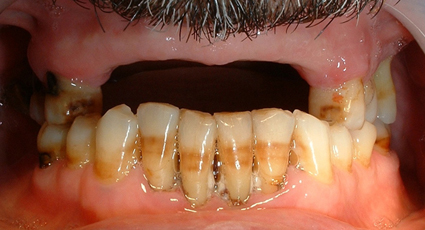
.
After
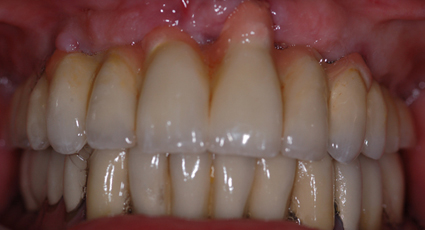
.
.
Will I need to make two visits to Buenos Aires to complete the treatment?
With the new techniques available we can perform the one stage technique, which means we can place a fixed prosthesis at the same time we place dental implants. This can be achieved when the bone quality and size is adequate. It can be done in one stage, with a stay of 7 to 14 days in BA, in only one visit.
.
If the bone has good quality we can do the implant + post + full porcelain crown in one hour, but we suggest stayin 7 days to make a follow-up appointment.
Single implant + post + crown = 1 to 7 days
Full mouth implants + posts + crowns = 14 days
.
Patients that undergo this treatment should have good general health and they should not overload the prosthesis in the first two months.
When a bone graft is necessary, or the bone quality and size is not appropriate, the general protocol states that you should wait three months with the lower jaw and four months with the upper jaw before placing the prosthesis over the dental implants. In those cases you will need to visit Buenos Aires twice. For the first stage you will need to stay one week, and in the second stage, 7 to 14 days dependind the number of crowns to be made.
.
.
Length of the treatment
.
One stage treatment, (full mouth implants + posts + crowns)= 14 days
One stage treatment, (single implant + post + crown)= 1 to 7 days
.
Two Stage Treatment
*First Stage (implants) = 1 to 7 days
*Second stage (posts and crowns)= 1 to 14 days
.
.
Smile #2: Single implant
.
Before
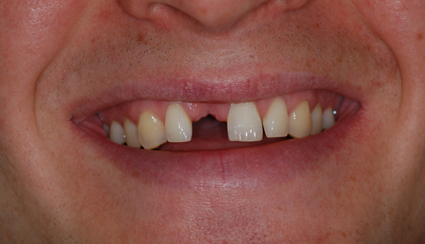
.
After
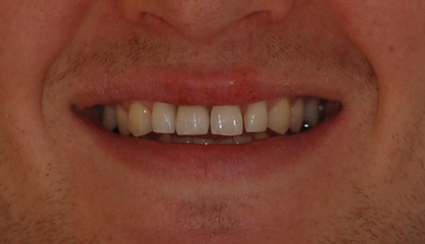
.
.
How do I know if I’m a good candidate for the one stage technique?
You can ask your local dentist if the one stage technique is possible in your case.
.
Sometimes the patient knows about his or her dental history and is aware of an existing bone loss.
.
You should have good health conditions.
.
It’s not recommended if you have:
* Osseous disease
* Jawbones with reduced size or bone quality
* Bruxism
* Diabetes
* Blood diseases
* Smoke
.
* Bad oral hygiene
.
Which brand of Dental implants do we use?
We use top quality brands of dental implants:
– B&W and Q-implant= Made in Argentina
– 3i Biomet= Made in US
.
.
What are the differences between 3I-Biomet, and B&W/Q-implant dental implants?
The B&W and Q-implant implants are more cost-effective, as they are made in Argentina and thus the production and material costs are lower. If you are looking to save even more money, these are a wonderful option as the quality is extremely high. The implant connection is standard and fully compatible with other brands over the world.
The 3i-Biomet dental implants are more expensive because of their fabrication, made in the USA. The benefits of these dental implants are that the healing phase is faster and they have a stronger implant connection.
When are 3i-Biomet implants recommended? Mainly when your jaw bone is extra hard and for individual implants.
.
.
Smile #3: Full mouth implants + crowns over teeth and implants
.
Before
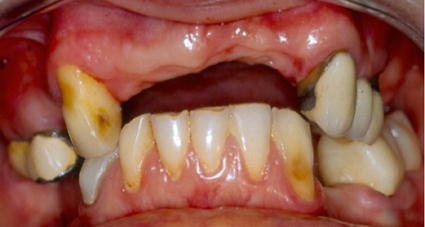
.
After
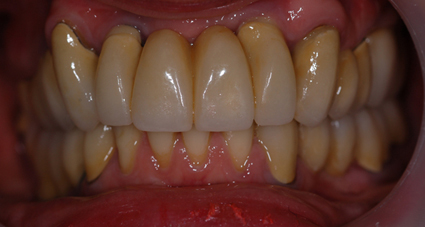
.
Do you use Microsurgical Guided Placed implant positioning, as Nobel Guide?
When placing several dental implants we use surgical guides to ensure that the implant positioning is correct.
.
.
Do I need to have the x-rays taken before coming to Dental DAS Argentina?
Having the x-rays before your arrival helps us to prepare your dental treatment project.
However, it’s not necessary; you can certainly have the dental x-rays done in Buenos Aires.
.
.
3D x-ray pictures in Buenos Aires, Argentina
.
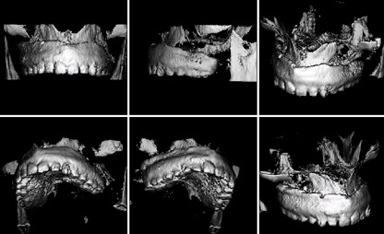
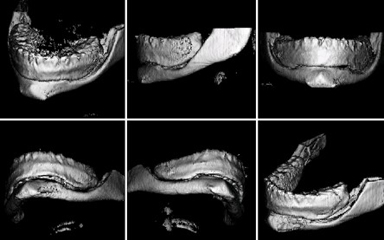
.
.
Do I need to have any blood tests completed before coming to Dental Argentina?
It’s convenient to have a routine blood test done before coming to Buenos Aires, as this is a way to save time, and spend fewer days in BA.
The blood test should include coagulation analysis.
.
.
Basic information about Dental Implants
.
If you find there are gaps in your smile where your permanent teeth used to be, you may realize that more is missing from your life than just teeth. You might have corresponding gaps in your health, and even your social life.
.
However, it doesn’t have to be this way. Dental implants are an excellent alternative to fill the holes left by tooth loss and here at Dental DAS Argentina we give you the best treatment at an affordable fee.
.
Many people are finding out that dental implants are more efficient, comfortable, and safe than dental bridges or even conventional dentures.
.
Dental implants are artificial tooth roots made of biocompatible titanium placed directly into the jawbone to replace a single missing tooth, without involving the adjacent teeth. After a period of a few months (the time varies by individual case) an implant-supported prosthesis is attached to the implant.
.
Unlike the old removable prostheses, this new alternative allows better function and aesthetics, providing greater stability while improving chewing efficiency and phonetics.
.
Dental Implants provide patients with a higher level of comfort, enhancing their overall quality of life.
.
.
BASIC FAQ‘s about Dental Implants
Are dental implants a possible treatment for you?
What happens during the surgical stage?
How is the dental implant placed?
Does it hurt to have dental implants placed?
What happens after dental implant positioning?
What happens during the prosthetic stage?
When is bone augmentation required?
How long do dental implants last?
What happens when a dental implant doesn’t work?
What are the risks and downsides of dental implants?
Making your dental implant successful
.
.
What are dental implants?
Dental implants are titanium cylinders that are placed into the jawbone of the patient, becoming an artificial root. In this way, the implant acts as an anchor for a false tooth or a whole set of false teeth. An extension, or abutment, is attached over the original implant. Finally, a realistic-looking artificial porcelain crown is attached to the abutment, creating a three-piece device that restores your smile. Depending on your personal situation, you may have just one, or many teeth replaced with dental implants.
.
Smile #4: Complex full mouth implants (6 dental implants upper jaw and 6 dental implants lower jaw)
.
Before upper jaw
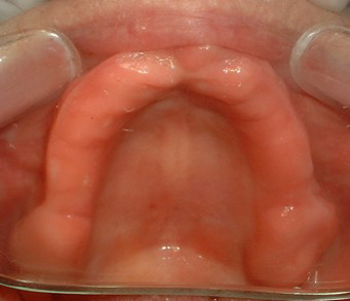
.
.
Before lower jaw
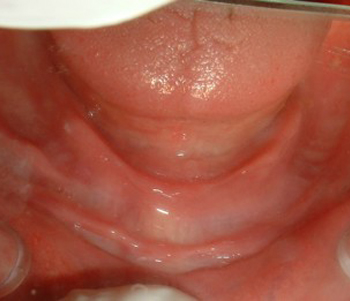
.
.
After
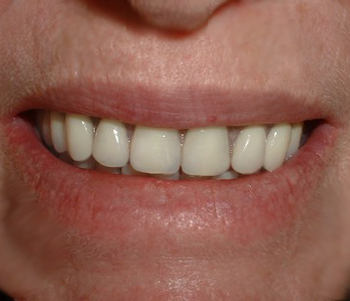 .
.
.
.
After
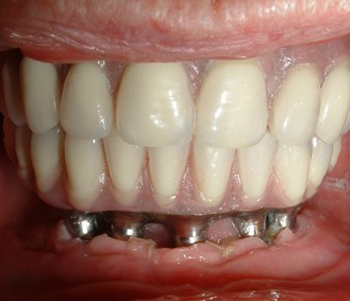 .
.
.
.
Are dental implants a possible treatment for you?
Most healthy adults, regardless of their age, are able to receive dental implants.
Dental implants might be a possible solution if you:
• Have lost one or more teeth. It’s important to remember that it is not a good idea to allow very much time to pass before replacing a lost tooth, as the bone’s volume tends to diminish as time goes by.
• Have healthy oral tissue.
• Want to protect your adjacent teeth (implants are the best alternative to bridgeworks).
• Are unwilling or unable to wear conventional dentures, because they can be loose and unstable.
• Your jawbone has reached its full growth.
• Possess a sufficiently strong jawbone, or if not, you are able to have a bone augmentation procedure.
• Don’t have any medical conditions that would impair bone healing.
• Want to smile again confidently. Some people with conventional prostheses are afraid their false teeth will move or even come off when they speak or smile.
• Wish to be able to chew and bite firmly again. With dental implants it is possible to chew and digest food more easily, and as a result have a greater enjoyment of meals.
.
.
What happens during the first stage?
Before the procedure itself begins, you will need to have a comprehensive evaluation.
First of all, it is necessary to fill out a health history form because we need to know about any medical conditions you may have and any medications you are taking, including prescriptions, over-the-counter medications or supplements. For example, if you have a heart condition, or vascular or orthopedic implants, we may prescribe antibiotics before implant placement in order to help prevent infection.
The next step will be a thorough dental exam. This may include dental X-rays (panoramic, peripheral, computed tomography, etc). Also, if needed, it will include making models of your mouth as well as a computerized three-dimensional reconstruction of your jawbones.
A treatment plan is then tailored to your individual situation. This plan takes into account numerous factors, such as the total number of teeth being replaced and the condition of your jawbone. If your jawbone is in proper conditions, the one stage technique can be done. So the implant, post and crown can be done in the same stage. We need you to stay in BA 1 to 14 days depending on the number of teeth involved.
If the two stages technique is performed, you should stay in BA 1 to 7 days for the first stage; and 1 to 14 days for the second one.
.
.
Severe bone loss – Two stage implants required. First stage pictures (only dental implants are placed)
.
Before 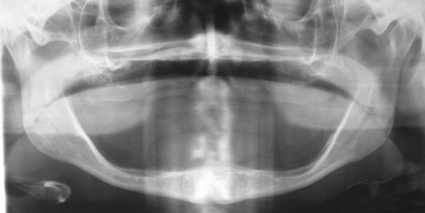 .
.
.
After 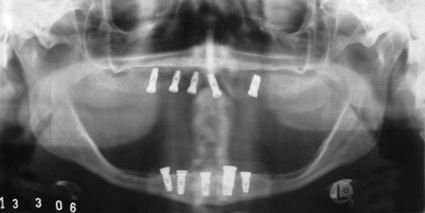
.
.
How is the dental implant placed?
The placement of dental implants and artificial teeth involves a procedure usually completed in two stages. The entire process takes three to nine months depending on the case; and sometimes longer.
Generally speaking, the dental implant cylinder is first implanted into your jawbone, (first stage) and after this you must undergo a healing period. For the next step, the abutment is placed (second stage), followed by a shorter healing period. Finally, you get your new artificial tooth, also known as an implant prosthesis or crown. Currently it is possible in certain patients to accelerate the healing time that is needed. In fact, in many cases we can perform an immediate loading technique, which means we place a fixed prosthesis the same day or short after we place dental implants. However, in those cases in which the jawbone conditions are not ideal, the general protocol states that you should wait three months with the lower jaw and four months with the upper jaw.
Some people may also require bone augmentation before the initial dental implant surgery, which of course lengthens the entire process.
Also, at times it is necessary to remove a futureless tooth and in this case we attach the dental implant through the hole that the root of the tooth leaves behind when it is removed.
After the first stage of implant placement, there will still be a gap where your tooth is missing. Usually, a temporary denture can be placed to fill in this gap.
Once the dental implant is placed in your jawbone, a process called Osseo integration begins. During this time, the jawbone fuses with the surface of the dental implant. This process usually lasts anywhere from three to six months. This is a very important step because it helps provide a strong, solid base for your new artificial tooth. With the one stage technique, the healing process starts at the same moment the implant is placed, and continues with the normal and moderate loadings.
.
.
Does it hurt to have dental implants placed?
The dental implant placement is usually completed on an outpatient basis in a dental office. You will receive local anesthesia for immediate pain control, and in some cases sedation is used. Also, after the procedure we will give you analgesics. The level of discomfort differs from patient to patient, but most do not have any significant problems. The overall procedure for dental implants is generally not a painful process.
In some cases, a micro-traumatic surgery can be performed. Whenever it’s possible, we use this microsurgery technique, and our patients have almost no discomfort at all. Using this new technique, blades and stitches are often completely unnecessary.
.
.
What happens after dental implant positioning?
We usually prescribe antibiotics and analgesic right away.
After the procedure is completed, you may experience some of the typical discomforts associated with any type of dental surgery. These might include:
• Bruising of your skin and gums
• Moderate swelling of your gums and face
• Mild pain at the implant site
• Minor bleeding
.
At times, after the dental implant placement it is recommended that the patient go without their prosthesis for a short period of time.
You may also need to eat only soft foods for five to seven days.
If the stitches aren’t self-dissolving, we will remove them in a period of four to ten days.
.
.
What happens at the prosthetic stage?
At this stage we place the abutment to which the crown will eventually be attached. Once the abutment is placed, the gum tissue will then be closed around, but not over, the abutment.
Once the abutment has been placed, your gums need to heal for one week, and then it is possible for the artificial tooth to be attached.
After the gums have healed, you will have impressions made of your mouth and remaining teeth. These impressions are then used to make the crown – your new realistic-looking artificial tooth, or prosthesis.
.
.
There are two main types of artificial teeth that we can choose from. They are:
• Fixed implant prosthesis: the artificial tooth is permanently cemented or screwed onto an individual implant abutment. There is no removing the tooth for cleaning or during sleep. Each crown is attached to its own particular dental implant. The implants and the prosthesis will become a permanent part of your mouth; and they will have all the same security and function as your own healthy teeth.
• Removable implant prosthesis: this is quite similar to a conventional removable denture, but is a more secure alternative. It is mounted on a metal frame that is attached to the implant abutment, and snaps securely into place. It can be easily removed for daily cleaning. Many times this is a good choice when several teeth in the lower jaw are replaced.
.
.
When is bone augmentation required?
If your jawbone is too soft or isn’t thick enough, you may need a bone augmentation procedure before or at the same time we place the dental implant. This is due to the fact that the strong chewing action of your mouth applies great pressure on the jawbone. If the bone can’t support the implant, it is likely that the procedure would be a failure. A bone augmentation process is capable of producing a far denser support for the implant.
The new bone will grow, but it will possibly take six to nine months to grow thick enough to support a dental implant. Some patients may only need a small bone augmentation, in which case this can be done at the same time as the implant surgery. It all depends on the condition of your jawbone.
.
.
How long do dental implants last?
Out of all dental procedures, dental implants last the longest. The success rate at ten years is over 97%.
If utilized correctly, and if care is taken with oral hygiene, implants have a proven durability of more than 20 years.
.
.
What happens when a dental implant doesn’t work?
Fortunately, this is rare, happening in very few cases. The implant success rate at our office is about 98-99%.
A dental implant may be rejected if the bone fails to fuse sufficiently to the titanium implant cylinder. If this happens, the implant is removed and the bone is cleaned up. We will place a new implant immediately, or, if necessary, in a month or two.
In addition, it is possible that the implant may become loose. If this happens, it is best to remove the dental implant and replace it with a new one, usually of a slightly larger size.
.
.
What are the risks and downsides of dental implants?
As with any surgery, receiving dental implants can pose health risks. Problems are quite rare though, and when they do occur they’re usually minor and are easily treated. Risks may include:
• Post-operative infection at the implant site
• Damage to adjacent structures, such as blood vessels, other teeth, or the nasal cavity
• Nerve damage, which may cause pain, numbness, or tingling in your natural teeth, gums, lips or chin on the operated side
• Sinus problems, if dental implants that are placed in the upper jaw protrude into one of your sinus cavities.
.
.
Making sure your dental implant is a success
Certainly, the majority of dental implants are successful. However, you can help your dental work (and also your remaining natural teeth) last longer if you:
• Practice excellent oral hygiene. Just like your natural teeth; implants, artificial teeth and gum tissue must be kept clean and free from bacteria. There are specially designed brushes, such as an inter-dental brush that slides between teeth, or floss, that can help clean the spaces in between teeth, gums and metal abutments. Also, special devices, like electronic mouth rinses, can help to improve hygiene. If hygiene is not proper, there could be an infection or an inflammatory condition in the soft tissue.
• Refrain from smoking. Dental implants have higher success rates in non-smokers than in smokers.
• Visit your dentist regularly. Schedule dental checkups every six to 12 months to ensure your health and that your implants are functioning properly.
• Stop harmful habits. Don’t chew on hard items, such as ice or hard candy, which could break your crowns, or your natural teeth. Also, try to avoid tooth-staining tobacco and caffeine products.
• Seek treatment if you clench or grind your teeth. If you don’t seek treatment, problems could arise with the connection between the implant and the crown.
.
.
If you have any questions, please contact us.
We will be pleased to answer your inquiry.
Dental Implants Buenos Aires












